Business
Orange juice, coffee and sugar continue rally; Warm weather to help wheat catch up
Favorable weather pushes for an increase in wheat production. Orange juice, coffee and sugar stocks remain consistently high in the weekly charts.

Wheat
Wheat markets were higher for the week in reaction to the estimates from the Kansas Wheat tour and on continued forecasts for dry weather in the Great Plains. The rains in the Great Plains are still hard to find, and the Kansas Wheat Tour found very poor crops and conditions as it moved through the state last week. It estimated total production in the state at 243 million bushels on average yields of 37 bushels per acre. The estimates imply that a significant part of the wheat-planted area in the western Great Plains will be abandoned and planted to something else.
Warmer and drier weather is expected for the Midwest to help speed crop development after some big rains this week. Warmer weather should also move out of the northern Great Plains and Canadian Prairies to allow for some fieldwork to start in Spring Wheat areas. USDA showed that fieldwork is much behind normal this week. Progress in planting spring wheat should increase with the warmer weather for the next week. The market has also been concerned about warm and dry weather in Ukraine and southern Russia.
There had been the talk of the potential for significant yield losses if rains did not appear in the short term. However, rains are in the forecast for these areas this week. Demand remains the big problem for wheat traders. The competition from eastern Europe and the Black Sea area remains very tough but might start to fade if the rains do not appear in both Ukraine and Russia.
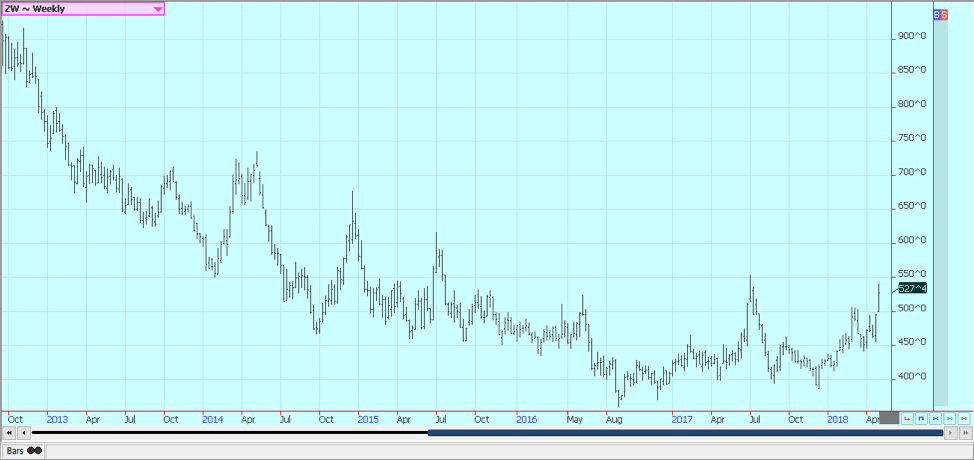
Weekly Chicago Soft Red Winter Wheat Futures © Jack Scoville

Weekly Chicago Hard Red Winter Wheat Futures © Jack Scoville
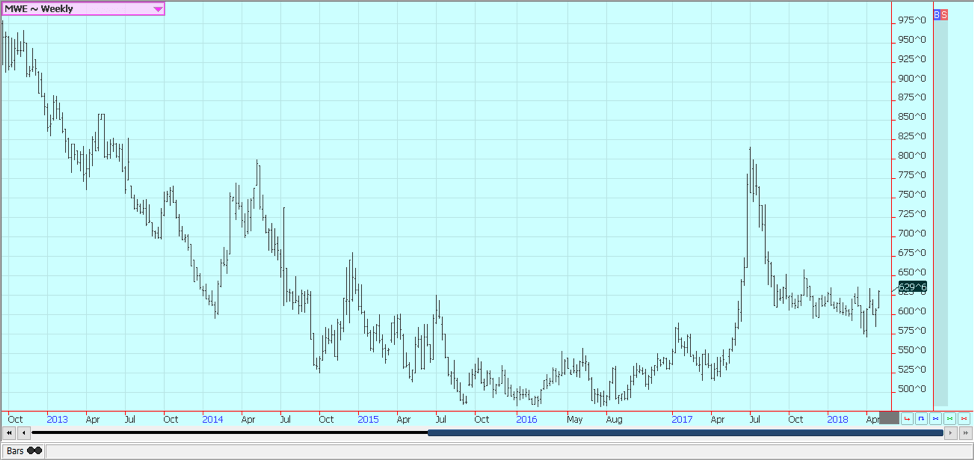
Weekly Minneapolis Hard Red Spring Wheat Futures © Jack Scoville
Corn
Corn closed higher for the week as the trade started to worry about second crop corn production potential in Brazil. The Safrinha crop is in trouble in parts of Parana and Mato Grosso at a key time in its development cycle. It is pollination and kernel fill time, but the weather has already turned hot and dry. It could be that the rainy season has ended early. If so, yield potential will shrink dramatically as the development of the crop will be sharply reduced.
Forecasts for better weather conditions to start planting in the Midwest were responsible for market price weakness. Planting progress in the US has been slow but should get a little faster last week with warmer temperatures. However, there is now some rain around to slow the planting progress once again. The rains should not be universal, but enough should fall to provide for overall delays. USDA could show that just over one-third of the crop has now been planted. Strong domestic and export demand ideas remain the best support for futures, but there is increasing talk of stronger competition from South America and Ukraine.
The worries of less demand are a direct result of the Trump administration threats against trading partners in world markets. Weather in the Midwest remains too cold and wet, but warmer and drier weather is expected this week to promote increasingly active fieldwork. It will take some time for areas north of Interstate 80 to thaw, but the trend to more seasonal conditions appears to have finally started.
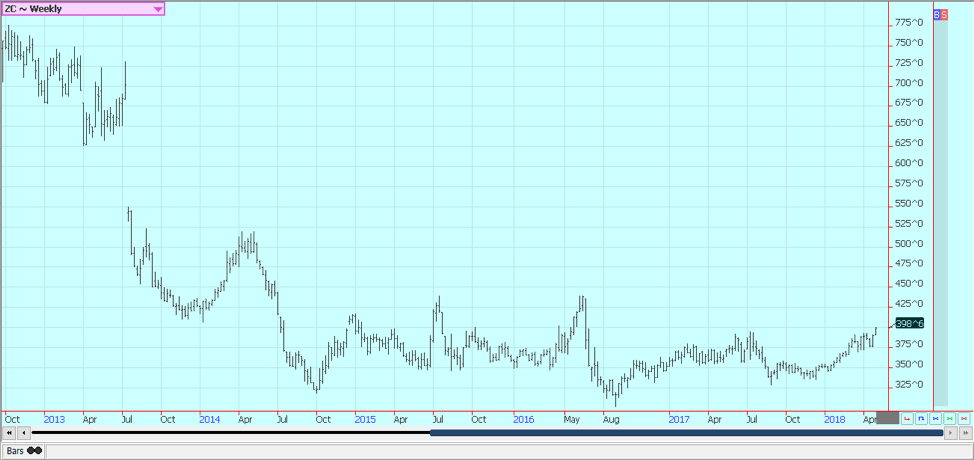
Weekly Corn Futures © Jack Scoville
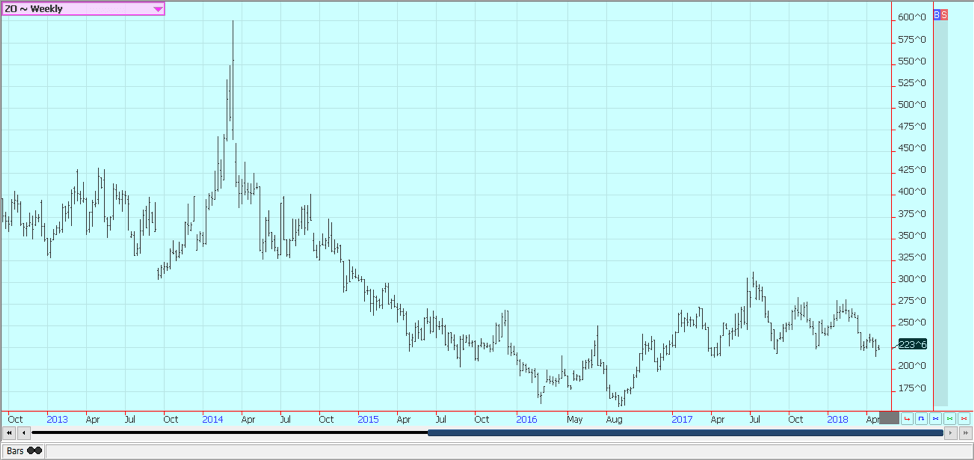
Weekly Oats Futures © Jack Scoville
Soybeans and soybean meal
Soybeans were lower last week as the US and China entered into talks to try to resolve the trade dispute. China said on Friday that no such thing happened. An agreement was found on some issues, but there are still a lot of issues that need to be resolved, and the differences are said to be big in some of these.
Demand is still an issue with traders as the tariff threats with China remain alive, but there are still hopes that the issues with China can be resolved before any punitive tariffs are enacted. There are very high-level meetings scheduled between the two sides this week. The trade also hopes for a peaceful solution to the NAFTA talks to keep Mexican and Canadian demand alive.
China still prefers Brazilian soybeans due to the tariff threats and as the new crop. Brazil harvest is now available, and the US stands to lose demand in coming weeks from that buyer and maybe others as Brazil expands market share. USDA showed almost no planting progress in its reports last week, and might not show much progress this week, but progress is increasing now. Farmers in parts of the southern Midwest are about done planting corn and will start to plant soybeans. Planting of corn and soybeans will increase in the north this week as better weather has finally arrived.
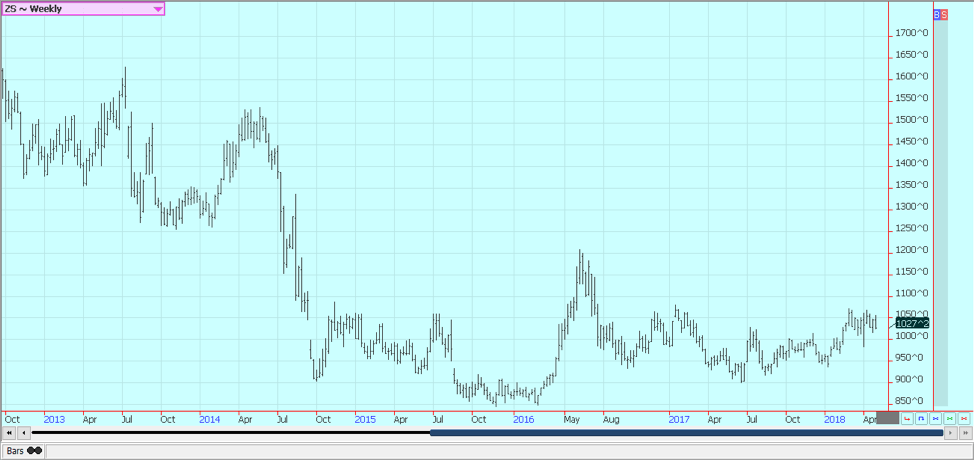
Weekly Chicago Soybeans Futures © Jack Scoville
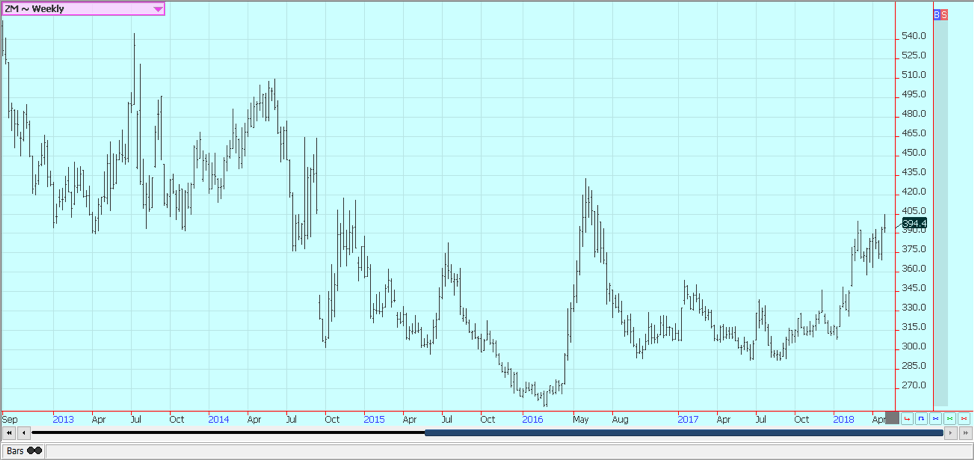
Weekly Chicago Soybean Meal Futures © Jack Scoville
Rice
Rice was lower for the week but held above major chart support at 1250 basis the nearest futures contract. Trends are mixed for the short term but still up on the weekly charts. The weekly charts are bullish and imply that further gains are likely in the coming weeks as the domestic market works with very tight supplies. Farmers are mostly done planting along the Gulf Coast. It remains too cool for many to plant farther to the north in Arkansas, but some significant fieldwork is underway and significant planting progress is being made.
Warmer and drier weather is forecast for this week, and there is a chance for more planting progress to be made. Ideas are that little old crop rice is available in the cash market, and the situation is not likely to improve before the new crop becomes available late this summer as farmers are mostly sold out. Farmers will plant more rice this year, but the increase in planted area is not considered burdensome.

Weekly Chicago Rice Futures © Jack Scoville
Palm oil and vegetable oil
World vegetable oils prices were mostly lower last week. Palm oil moved lower as export demand continued to fade in Malaysia. Malaysian private sources reported that exports for April were well below those for March. China has been importing mostly from Indonesia and India is out of the market for now. China has been crushing a lot of soybeans and has been producing its own soybean oil. The weekly charts show that palm oil trends have turned down again as the weaker demand is being met by reports of better production. A downtrend can continue.
Soybean oil was locked in a sideways to downtrend all week. Canola found some support from the trade war and also from the very cold weather in the Canadian Prairies. The cold weather has made any fieldwork impossible at this time. The region looks to turn warmer this week. StatsCan showed that Canadian farmers plan to reduce oilseeds plantings this year and increase grains plantings. That could keep canola relatively firm compared to soybeans and soybean oil.
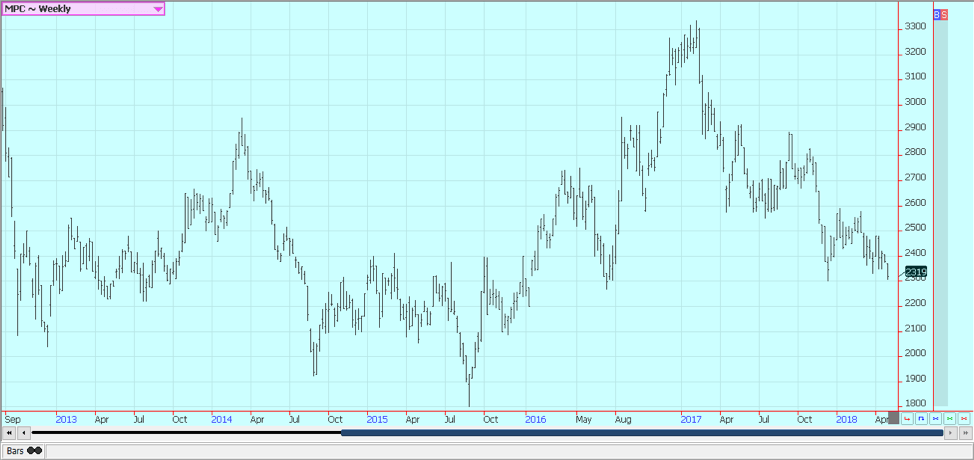
Weekly Malaysian Palm Oil Futures © Jack Scoville
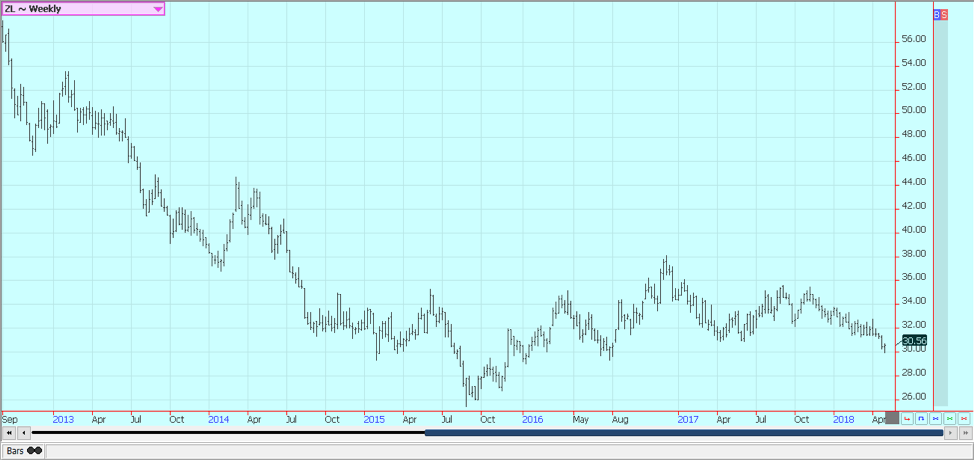
Weekly Chicago Soybean Oil Futures © Jack Scoville
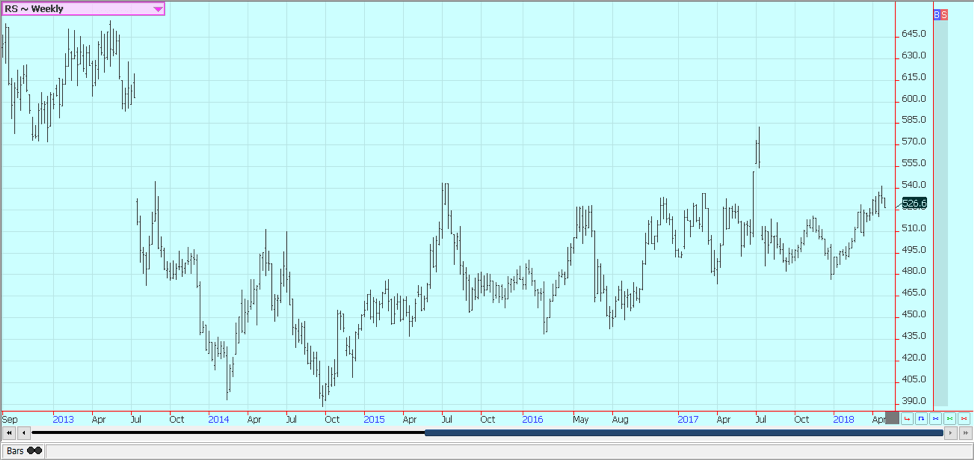
Weekly Canola Futures © Jack Scoville
Cotton
Cotton was higher on the poor weather in Texas and on ideas of tight available supplies. There are ideas that the US is now running short of high-quality cotton to deliver to the exchange and to overseas buyers. Demand remains strong in export markets as the weekly export sales report showed moderate to strong volumes last week. Chart trends are mixed on daily charts and up on weekly charts. New crop planting has been slow, but not unusually slow when compared to last year and the five-year average.
The weather in the western Great Plains is showing some improvement as some areas have finally seen some precipitation. However, the precipitation was minimal and not of much benefit to farmers. Forecasts call for mostly dry weather for the next couple of weeks, and producers in the western Great Plains are likely to wait for better rains before planting more cotton. In contrast, farmers in the Delta and Southeast have seen too much rain and have had delays as soils dry out. The overall planting pace is likely to remain slow.
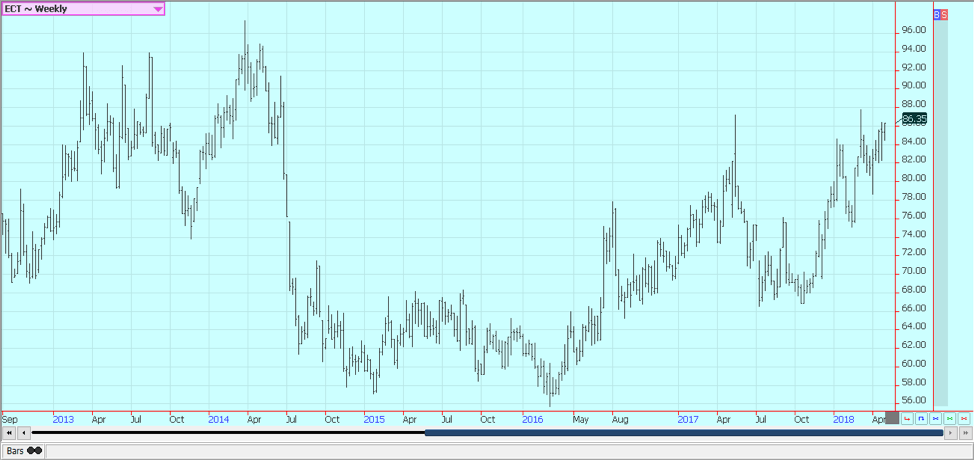
Weekly US Cotton Futures © Jack Scoville
Frozen concentrated orange juice and citrus
FCOJ was higher as the rally continued. Funds and other speculators have been the best buyers, and producers here and in Brazil have not been selling that much. It looks like FCOJ is in a weather market as dry conditions are reported in Florida and in production areas of Brazil. The weather has been dry and the harvest is starting to wind down in some áreas of Florida. The market is still dealing with a short crop against weak demand.
The current weather is good as temperatures are warm and it is mostly dry, but some rains were reported over the week. The harvest is progressing well and fruit is being delivered to processors. Producers are now into the Valencia crop. Florida producers are seeing pea-sized to marble-sized fruit. Conditions are reported as generally good, although most producers would like more rain. Irrigation is being used. Brazil also could use more rain as Sao Paulo has been hot and dry. Variable conditions are reported in Europe and northern Africa.
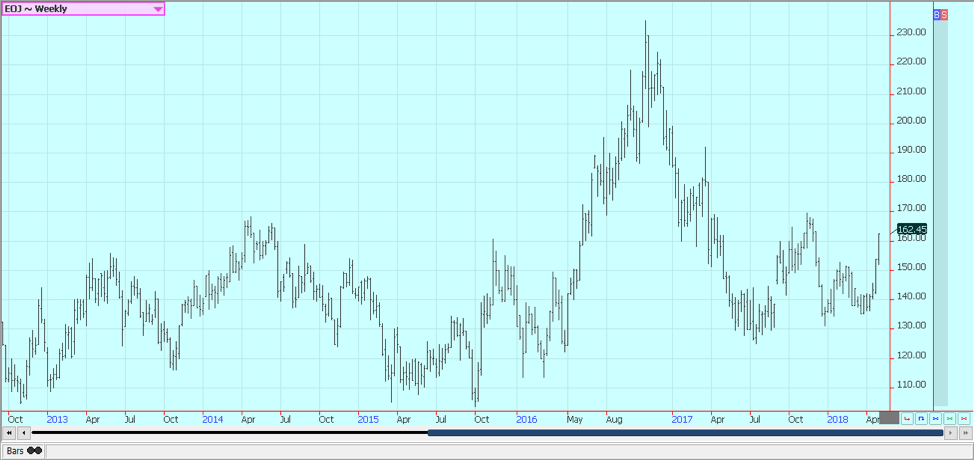
Weekly Frozen Concentrated Orange Juice Futures © Jack Scoville
Coffee
Futures in New York were higher for the week as strong commercial buying along with speculative short covering. The weekly charts show that a reversal might have happened in the last couple of weeks. London was a little higher and has a price positive price pattern. More talk is being heard about the size of the net short speculative position, with ideas around that it has become way too big. More and more traders are now looking for the market to reverse as the speculator gets out of short positions and tries to book profits. Some traders now think a significant rally is just around the corner.
Origin is still offering in Central America and is still finding weak differentials. Good business is getting done and exports are active. Traders anticipate big crops from Brazil and from Vietnam this year and have remained short in the market. New York traders are talking about good weather currently being reported in Brazil and expect another bumper crop. Robusta remains the stronger market as Vietnamese producers and merchants are not willing to sell at current prices and are willing to wait for a rally. Vietnamese cash prices were steady again last week with good supplies noted in the domestic market.
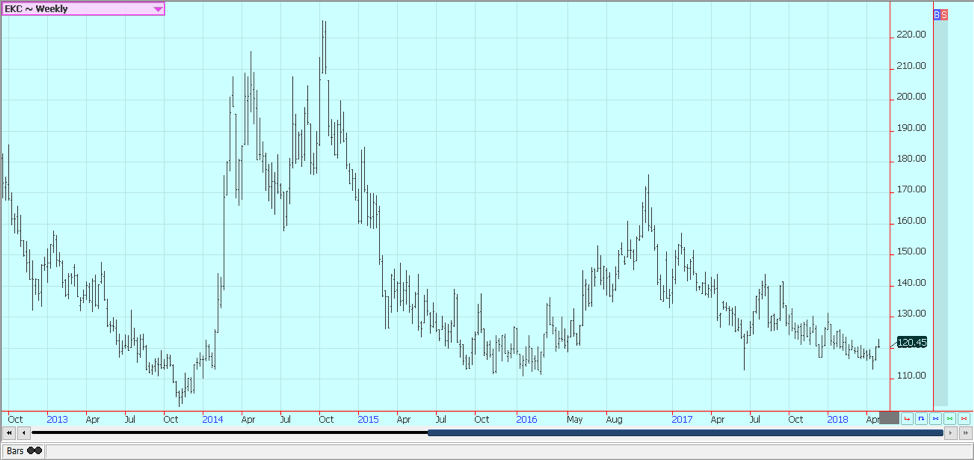
Weekly New York Arabica Coffee Futures © Jack Scoville

Weekly London Robusta Coffee Futures © Jack Scoville
Sugar
Futures were higher in both markets for the week. It appeared to be a short-term short covering rally after new lows for the move were made the previous week and as May futures went off the Board in New York. The Brazil season is off to a big start, causing the selling interest as the market now expects even more sugar to be available. There has been little in the way of positive news for traders in the last year as production estimates have climbed and demand estimates have not. The fundamentals remain little changed, and there does not seem to be much, for now, that can shake the market out of its current trend.
Traders hear about big production from the world producers and little in the way of special demand that could absorb some of the surplus. Ideas that sugar supplies available to the market can increase in the short term have been key to any selling. India is back to export Sugar this year after being a net importer for the last couple of years. They hope to export 2.0 million tons this year but will have a surplus that is double that amount. Thailand has produced a record crop and is selling. Brazil still has plenty of sugar to sell, and even the EU has had over production in the past year.
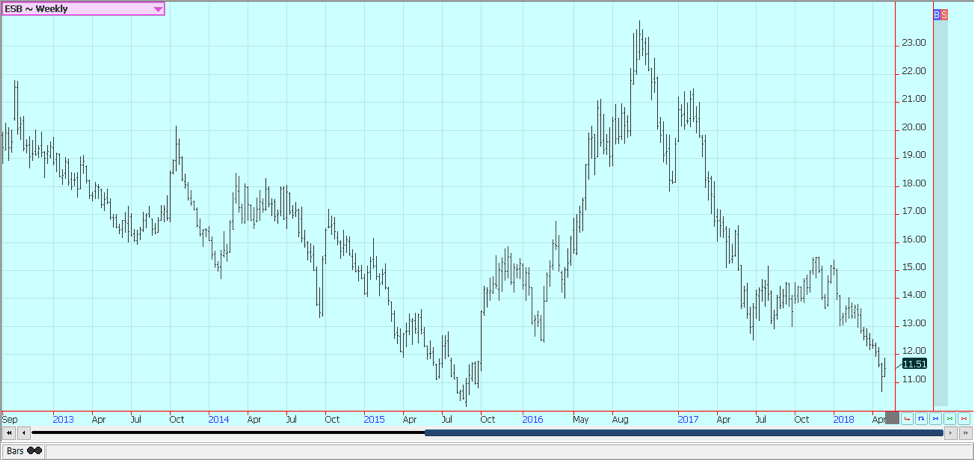
Weekly New York World Raw Sugar Futures © Jack Scoville

Weekly London White Sugar Futures © Jack Scoville
Cocoa
Futures were lower in both New York, but higher London last week. The spread between New York and London has now begun to correct back to more normal levels as New York is losing its steam to move higher but as London continues to rally. This is due to fund buying in New York, but also due to increased Cameroon offers in Europe. European buyers do not like Cameroon’s cocoa, so the supplies have been certified in London for delivery. So, the longs in London are leaving the market to avoid having to take Cameroon’s cocoa. The big spread implies that African cocoa can make it to New York for delivery and generate profits for sellers.
Asian supplies are now less available since Asian grinding capacity has increased, so New York has space for African cocoa. Ideas that world production has been largely sold remain part of the rally. Showers and more seasonal temperatures have been seen in the last few weeks to improve overall production conditions in West Africa. The mid crop harvest is starting, and wire reports indicate that some initial mid crop harvest is underway in all countries. Estimates imply that variable yields can be expected. The harvest is underway now in Ivory Coast and Ghana.
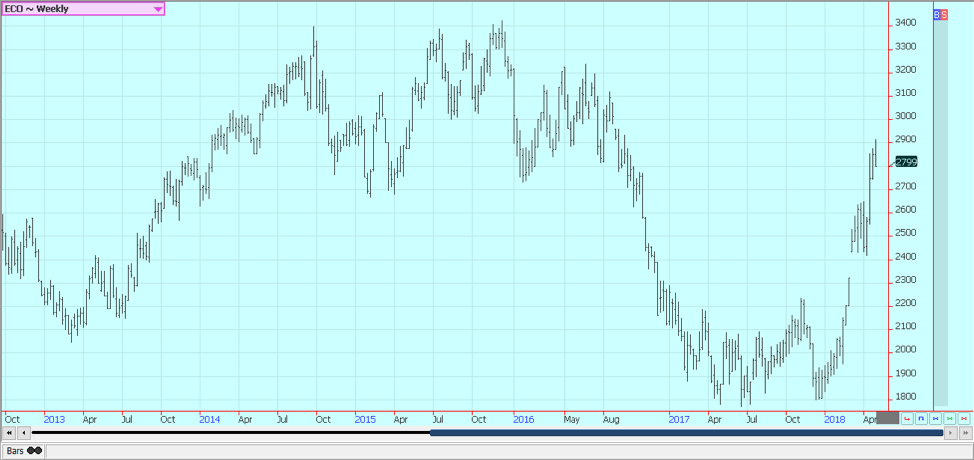
Weekly New York Cocoa Futures © Jack Scoville
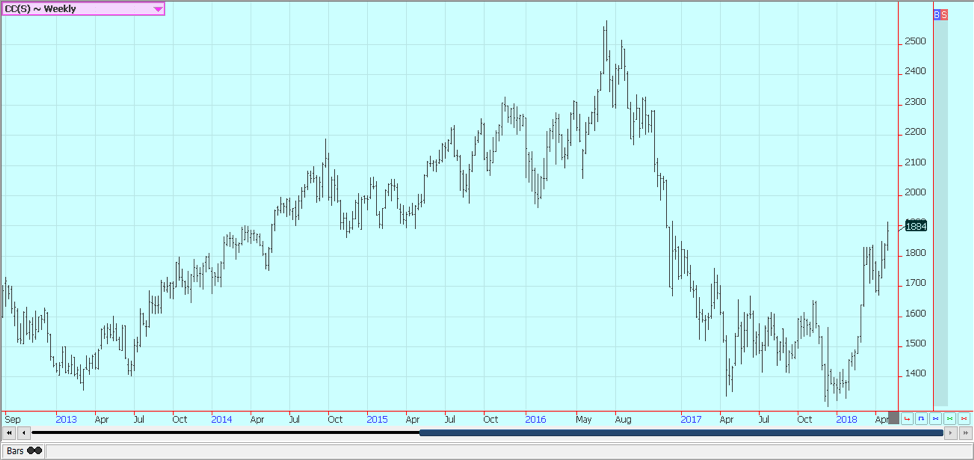
Weekly London Cocoa Futures © Jack Scoville
—
DISCLAIMER: This article expresses my own ideas and opinions. Any information I have shared are from sources that I believe to be reliable and accurate. I did not receive any financial compensation in writing this post, nor do I own any shares in any company I’ve mentioned. I encourage any reader to do their own diligent research first before making any investment decisions.

-

 Crowdfunding2 weeks ago
Crowdfunding2 weeks agoReal Estate Crowdfunding Gains Traction as Peruvians Seek Alternatives After AFP Withdrawals
-

 Africa5 days ago
Africa5 days agoMorocco’s Agri-Food Sector Poised for Strategic Growth
-

 Fintech2 weeks ago
Fintech2 weeks agoAmundi Enters Tokenization Era as Ethereum Regains Momentum Amid Market Volatility
-

 Crowdfunding7 days ago
Crowdfunding7 days agoAI Venture Builder Closes Major £2.5M Round, Strengthening Its Role in Europe’s AI Ecosystem


























You must be logged in to post a comment Login